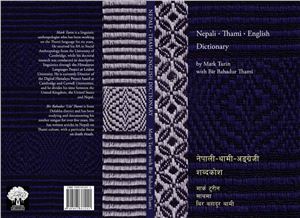Publication date: 2000.
Number of pages: 61.
This dictionary has been a long time in the making. I started working on the Thami language, called Thangmi by the people who speak it, in 1996. When I started I knew nothing about the language or the ethnic community of its speakers, and was surprised to discover that few other scholars of Nepal knew much either.
As I got to know Thangmi speakers in the Dolakha and Sindhupalcok districts of central-easte Nepal, and discovered that the population of this little-known ethnic community was over 20,000, the lack of published work on their language and culture seemed even more surprising. While my research for my PhD dissertation was on the grammar of Thangmi, the Thangmi speakers with whom I was working were naturally more interested in a having me publish a dictionary in the Nepali (Devanagari) script. My PhD thesis, they rightly argued, would only be available in English and would be written using complicated linguistic terms and would therefore remain inaccessible to them. A concise dictionary, or more accurately a 'word list', in a script which they could read would be of far greater utility to the community. With this request in mind I have compiled this Nepali-Thami-English Dictionary.
Let me take a moment to explain how this book came about and why it is structured in the way it is. First, the present book is not really a 'dictionary' according to the strict definition of the term. The word listings are not contextualised in any way, there is no analysis of the grammar of Thangmi. Example sentences are also not provided. This is not so much an academic book as a practical reference book. Many Thangmi friends and colleagues have asked me if I would undertake to write down, once and for all, the core of their vocabulary in the form of a concise book. Due to constraints of time and pace, unfortunately I am not able to elaborate on the grammatical structure of the Thangmi language here. For those readers interested in Thangmi grammar, phonology and morphology, I ask that they contact me and I will be happy to send them academic articles that I have published on these topics.
Number of pages: 61.
This dictionary has been a long time in the making. I started working on the Thami language, called Thangmi by the people who speak it, in 1996. When I started I knew nothing about the language or the ethnic community of its speakers, and was surprised to discover that few other scholars of Nepal knew much either.
As I got to know Thangmi speakers in the Dolakha and Sindhupalcok districts of central-easte Nepal, and discovered that the population of this little-known ethnic community was over 20,000, the lack of published work on their language and culture seemed even more surprising. While my research for my PhD dissertation was on the grammar of Thangmi, the Thangmi speakers with whom I was working were naturally more interested in a having me publish a dictionary in the Nepali (Devanagari) script. My PhD thesis, they rightly argued, would only be available in English and would be written using complicated linguistic terms and would therefore remain inaccessible to them. A concise dictionary, or more accurately a 'word list', in a script which they could read would be of far greater utility to the community. With this request in mind I have compiled this Nepali-Thami-English Dictionary.
Let me take a moment to explain how this book came about and why it is structured in the way it is. First, the present book is not really a 'dictionary' according to the strict definition of the term. The word listings are not contextualised in any way, there is no analysis of the grammar of Thangmi. Example sentences are also not provided. This is not so much an academic book as a practical reference book. Many Thangmi friends and colleagues have asked me if I would undertake to write down, once and for all, the core of their vocabulary in the form of a concise book. Due to constraints of time and pace, unfortunately I am not able to elaborate on the grammatical structure of the Thangmi language here. For those readers interested in Thangmi grammar, phonology and morphology, I ask that they contact me and I will be happy to send them academic articles that I have published on these topics.

